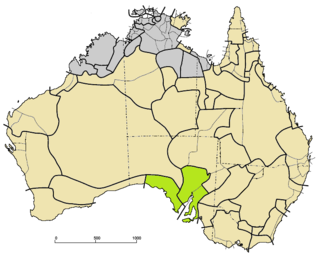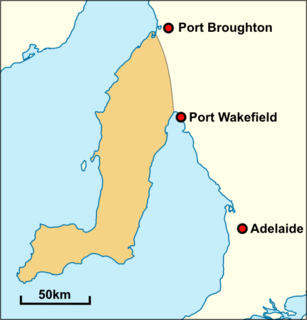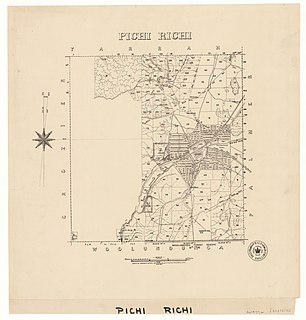The Kaurna people are a group of Indigenous Australians whose traditional lands include the Adelaide Plains of South Australia. Pronunciation of the word "Kaurna" varies slightly by the background and origin of the speaker; the most common is English, sometimes, native [ɡ̊auɳa] or, less often,. They were known as the Adelaide tribe by the early settlers. Kaurna culture and language were almost completely destroyed within a few decades of the European settlement of South Australia in 1836. However, extensive documentation by early missionaries and other researchers has enabled a modern revival of both language and culture.

The Ngarrindjeri people are the traditional Aboriginal Australian people of the lower Murray River, western Fleurieu Peninsula, and the Coorong of the southern-central area of the state of South Australia. The term ngarrindjeri means "belonging to men", and refers to a "tribal constellation". The Ngarrindjeri actually comprised several distinct if closely related tribal groups, including the Jarildekald, Tanganekald, Meintangk and Ramindjeri, who began to form a unified cultural bloc after remnants of each separate community congregated at Raukkan, South Australia.

The Mid North is a region of South Australia, north of the Adelaide Plains, but not as far north as the Far North, or the outback. It is generally accepted to extend from Spencer Gulf east to the Barrier Highway, including the coastal plain, the southern part of the Flinders Ranges, and the northern part of the Mount Lofty Ranges. The area was settled as early as 1840 and provided early farming and mining outputs for the fledgling colony. Farming is still significant in the area, particularly wheat, sheep and grapevines. There are not currently any significant mining activities in the Mid North.

The Adnyamathanha are a contemporary Indigenous Australian people from the Flinders Ranges, South Australia, formed as an aggregate of several distinct peoples. Strictly speaking the ethnonym Adnyamathanha was an alternative name for the Wailpi. Adnyamathanha is also often used as the name of their traditional language, although the language is more commonly called "yura ngarwala" by Adnyamathanha people themselves.
Kaurna is a Pama-Nyungan language historically spoken by the Kaurna peoples of the Adelaide Plains of South Australia. The people of the Adelaide plains are known as the Kaurna people in contemporary times, but the Kaurna nation is made up of various tribal clan groups, each with their own parnkarra district of land, each having had their own dialectal form of language. These dialects were historically spoken in the area of the Adelaide Plains bounded by Crystal Brook and Clare in the north, Cape Jervis in the south, and just over the Mount Lofty ranges. It ceased to be spoken on an everyday basis in the 19th century, but, in a process that began in the 1990s, is being reclaimed and re-introduced.
The Ngadjuri people are a group of Aboriginal Australian people whose traditional lands lie in the mid north of South Australia with a territory extending from Gawler in the south to Orroroo in the Flinders Ranges in the north.

The Yura or Thura-Yura languages are a group of Australian Aboriginal languages surrounding Spencer Gulf and Gulf St Vincent in South Australia, that comprise a genetic language family of the Pama–Nyungan family.

The Narungga, otherwise known as the Narangga, are a group of Indigenous Australians whose traditional lands are located throughout Yorke Peninsula, South Australia.
Narungga is an Australian Aboriginal language formerly spoken by the Narungga people in Yorke Peninsula, South Australia. As a result of the colonisation of Australia, the Narungga language fell into disuse within several generations. Nevertheless, Narungga continued to be documented into the 20th century, and the 1980s saw a community reclamation. As a result of revival efforts, the language along with Narungga culture is now being taught around the Yorke Peninsula, from Moonta and Maitland Area Schools to Point Pearce.
Nukunu is a moribund Australian Aboriginal language spoken by Nukunu people on Yorke Peninsula, South Australia. As of 2017, there is a revival and maintenance programme under way for the language.

The Wilyakali or Wiljaali are an Australian aboriginal tribal group of the Darling River basin in Far West New South Wales, Australia. Their traditional lands centred on the towns of Broken Hill and Silverton and surrounding country. Today the Wilyakali people of Broken Hill are still the main Aboriginal group living in Broken Hill.

Gladys Elphick was an Australian Aboriginal woman of Kaurna and Ngadjuri descent, best known as the founding president of the Council of Aboriginal Women of South Australia, which became the Aboriginal Council of South Australia in 1973. She was known to the community as Auntie Glad.
The Aboriginal South Australians are the Indigenous people who lived in South Australia prior to the British colonisation of South Australia, and their descendants and their ancestors. There are difficulties in identifying the names, territorial boundaries, and language groups of the Aboriginal peoples of South Australia, including poor record-keeping and deliberate obfuscation, so only a rough approximation can be given here.
The Ngayawang, or Ngaiawang were an Aboriginal Australian people of the Lower Murray area of South Australia. They are now considered extinct.

The Hundred of Boolcunda is a cadastral hundred of the County of Newcastle in South Australia. It was proclaimed by Governor Anthony Musgrave in 1876.
The Hundred of Yarra is a cadastral hundred of the County of Newcastle in South Australia.
The Hundred of Cudlamudla is a cadastral hundred of the County of Newcastle in South Australia, that is located at 32.195°S 138.215°E. The traditional owners of the area are the Ngadjuri peoples/ and the first European explorer to the area was Thomas Burr in September 1842.

The Hundred of Pichi Richi is a cadastral hundred of the County of Newcastle in South Australia, located at 32.195°S 138.215°E and 293 m (961 ft) above sea level. Spanning the eastern slopes of Dutchman Range and centered on the township of Quorn.
The Hundred of Palmer is a cadastral hundred of the County of Newcastle in South Australia. It is located near 32.195°S, 138.215°E east of the township of Quorn, and south of the former town of Willochra which, although surveyed in 1860, never properly developed and was abandoned during the drought in the 1860s.

Mimbara Conservation Park is a protected area in the Australian state of South Australia located in the locality of Worlds End about 147 kilometres (91 mi) north-east of the state capital of Adelaide and about 22 kilometres (14 mi) south-east of the town of Burra.








